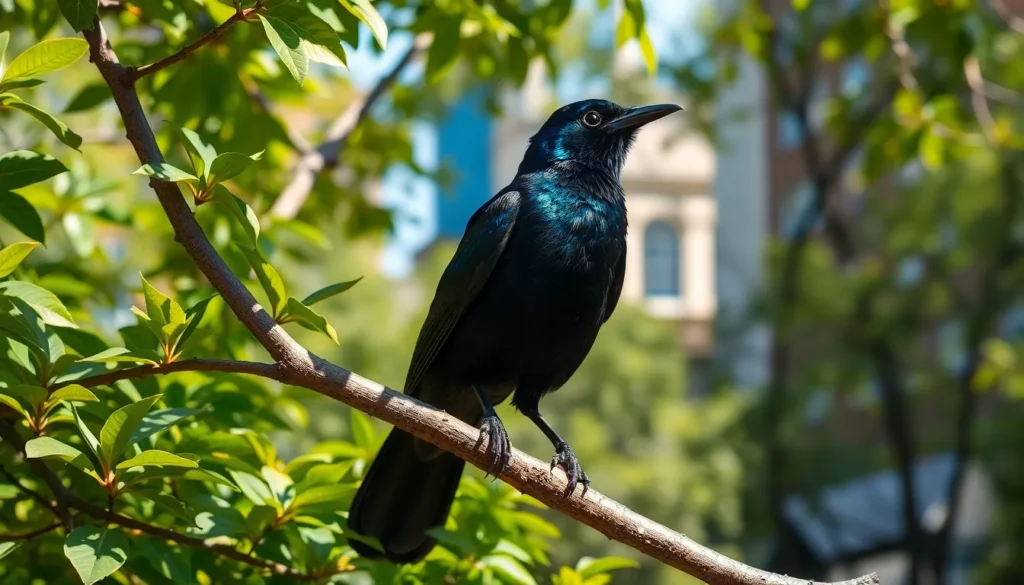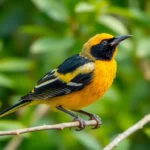We’ve all encountered those sleek black birds strutting confidently across parking lots and gathering in massive flocks that seem to take over entire neighborhoods. Grackles are among North America’s most recognizable yet misunderstood birds – and they’re far more fascinating than most people realize.
These intelligent corvids aren’t just another backyard bird. They’re sophisticated problem-solvers with iridescent plumage that shifts from deep black to stunning purple and bronze in the sunlight. From their remarkable ability to mimic sounds to their complex social behaviors grackles have earned their place as one of nature’s most adaptable survivors.
Whether you’re trying to identify the birds dominating your bird feeder or you’re curious about those dramatic murmurations filling the evening sky we’re here to dive deep into the industry of grackles. Let’s explore what makes these birds so successful – and why they’ve become such a dominant force in urban and suburban environments across the continent.
Physical Characteristics of the Grackle Bird
Grackles possess unmistakable physical features that make them easily recognizable among North American birds. These adaptable birds display remarkable variations in appearance across different species and between males and females.
Size and Build
Common grackles measure 11 to 13 inches in length with wingspans reaching 14 to 18 inches. Males typically weigh between 3.2 to 5.0 ounces while females range from 2.6 to 4.1 ounces. Their bodies feature a sleek streamlined profile with long graduated tails that often appear keel-shaped during flight. The birds maintain an upright posture when perched and their legs appear proportionally long compared to their body size.
Great-tailed grackles demonstrate even more impressive dimensions with males reaching 15 to 18 inches in length. Females of this species measure 11 to 13 inches making them comparable to common grackle males. Both species possess strong pointed bills perfectly adapted for their omnivorous feeding habits.
Distinctive Plumage and Coloration
Grackle feathers create stunning iridescent displays that shift between bronze purple and green depending on lighting conditions. Males exhibit the most vibrant coloration with heads and necks showing brilliant blue or purple sheens. Their bodies typically display bronze or copper tones that transform into greenish hues on the wings and tail.
The iridescence results from microscopic structures in their feathers that reflect light at different angles. Sunlight reveals the full spectrum of their metallic plumage while overcast conditions make grackles appear almost black. Juvenile grackles lack this iridescent quality and present uniform brown coloration until their first molt.
Sexual Dimorphism
Male grackles significantly outsize their female counterparts in both length and weight measurements. Common grackle males average 20% larger than females while great-tailed grackle males can be up to 60% larger. This size difference represents one of the most pronounced examples of sexual dimorphism among North American songbirds.
Females display more subdued coloration with less pronounced iridescence compared to males. Their plumage appears predominantly brown with subtle bronze tints rather than the vibrant metallic sheens of males. During breeding season males develop even more intense coloration and their tail feathers become more dramatically keeled for courtship displays.
Habitat and Geographic Distribution
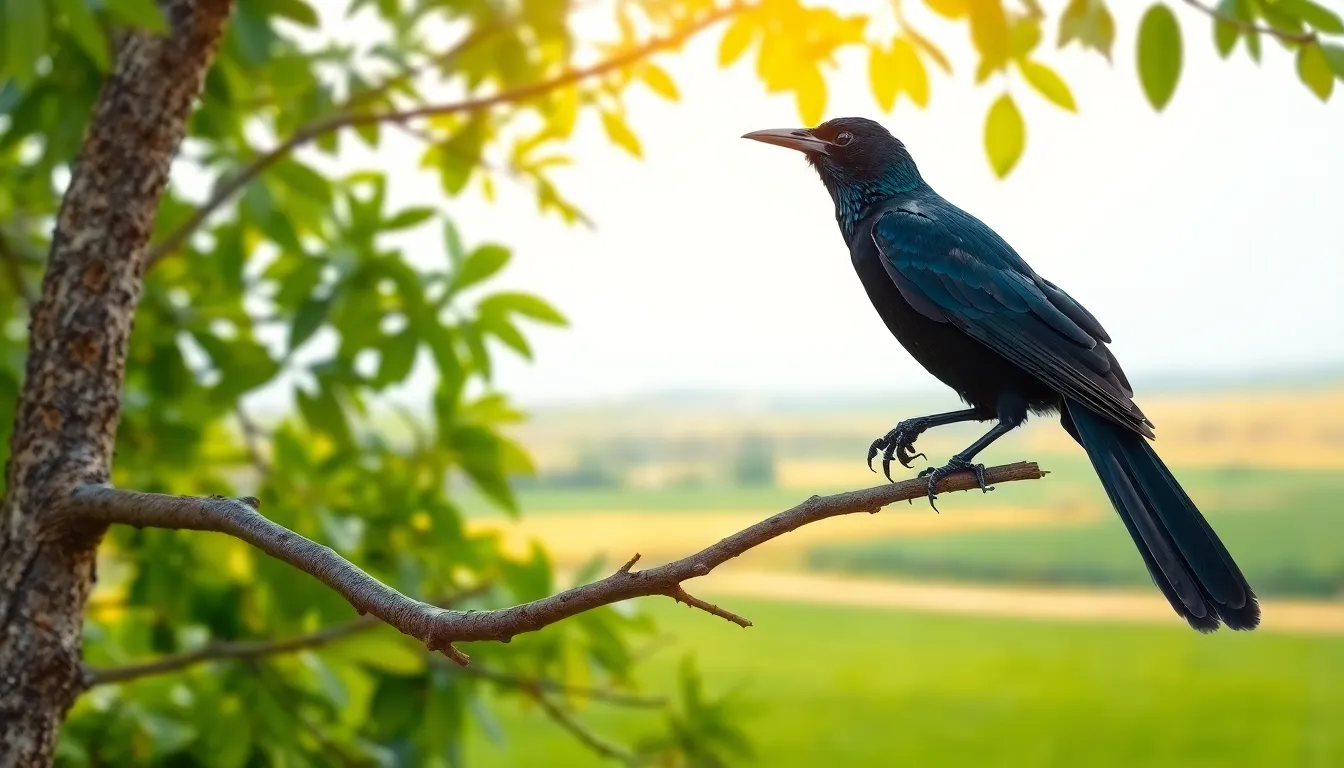
Grackles occupy a vast territory spanning most of North America, demonstrating remarkable adaptability to diverse environments. These intelligent birds have expanded their range significantly over the past century, thriving in both natural and human-modified landscapes.
Natural Range Across North America
Common grackles inhabit regions from southern Canada to the Gulf Coast, covering virtually the entire eastern two-thirds of North America. Their distribution extends from the Atlantic coast westward to the Rocky Mountains, with populations particularly dense in the Great Plains and Mississippi River Valley. Great-tailed grackles occupy a more southern range, stretching from central California through Texas and south into Central America.
Boat-tailed grackles maintain coastal distributions along the Atlantic and Gulf coasts, from New Jersey to Texas. These regional variations reflect each species’ exact environmental adaptations and food preferences. Migratory patterns vary among populations, with northern grackles moving south during harsh winters while southern populations remain year-round residents.
Seasonal movements follow predictable routes, with large flocks congregating in agricultural areas during fall and winter months. Climate change has enabled range expansions northward, particularly for great-tailed grackles, which now breed in areas previously too cold for successful reproduction.
Preferred Environments and Nesting Areas
Grackles prefer semi-open habitats that combine trees for roosting with open areas for foraging. Agricultural landscapes provide ideal conditions, offering grain crops, scattered woodlots, and water sources. Urban parks, golf courses, and suburban neighborhoods with mature trees support thriving grackle populations.
Wetland edges rank among their most favored nesting locations, providing abundant insect protein for developing chicks. Cattail marshes, pond margins, and stream corridors offer both nesting sites and diverse food sources. These areas typically feature water depths of 1 to 3 feet with emergent vegetation.
Colonial nesting occurs in dense vegetation, with 10 to 30 pairs often nesting within a single acre. Coniferous trees like spruce and pine provide preferred nesting structures, though grackles readily adapt to deciduous species. Nest heights range from 3 to 20 feet above ground, with most positioned between 6 to 12 feet for optimal protection.
Human-modified environments increasingly support grackle populations through consistent food availability and reduced predation pressure. Shopping center parking lots, fast-food restaurants, and residential bird feeders create reliable feeding opportunities. These urban adaptations demonstrate the species’ behavioral flexibility and opportunistic feeding strategies.
Behavior and Social Structure
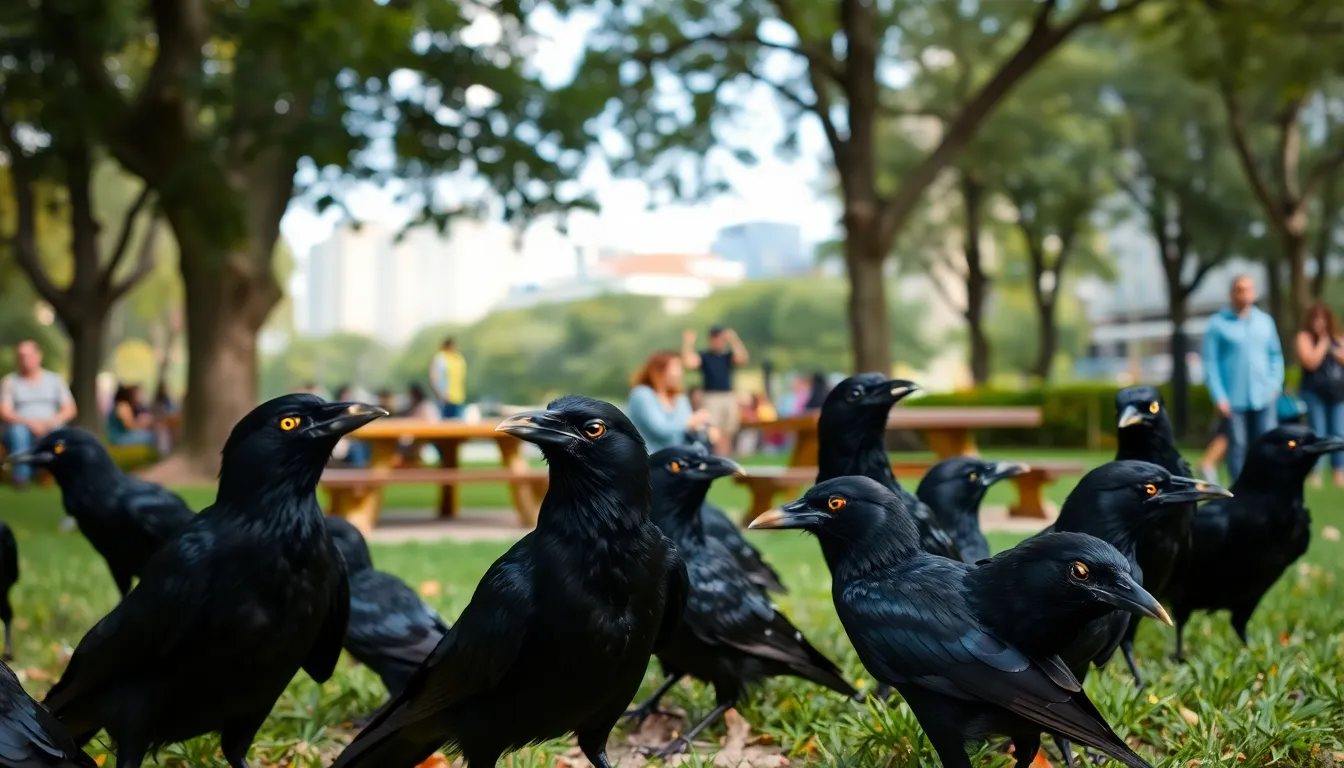
Grackles exhibit complex social behaviors that demonstrate their intelligence and adaptability in diverse environments. Their behavioral patterns cover sophisticated feeding strategies, intricate communication systems, and ever-changing mating rituals that contribute to their success as urban and suburban residents.
Feeding Habits and Diet
Grackles display omnivorous feeding behaviors that adapt to seasonal availability and environmental conditions. Their diet includes insects like beetles and grasshoppers during spring and summer months, providing essential protein for growing chicks. Agricultural crops such as corn, wheat, and sunflower seeds comprise 60% of their annual food intake, making them important players in farming ecosystems.
Common Grackle Diet Composition
| Food Type | Percentage | Seasonal Peak |
|---|---|---|
| Agricultural grains | 60% | Fall/Winter |
| Insects and larvae | 25% | Spring/Summer |
| Small vertebrates | 10% | Year-round |
| Fruits and berries | 5% | Late summer |
Foraging techniques vary based on food sources and habitat conditions. Ground foraging involves methodical searching through leaf litter and grass, where grackles use their pointed bills to probe soil for earthworms and grubs. Cooperative foraging occurs when multiple birds work together to expose hidden insects beneath bark or disturb ground cover.
Urban environments provide consistent food sources through garbage bins, pet food, and bird feeders. Grackles remember productive feeding locations and return repeatedly, demonstrating spatial memory capabilities that enhance their survival rates in human-modified landscapes.
Flocking Patterns and Communication
Grackle flocking behavior changes dramatically throughout the year, creating some of the most spectacular bird aggregations in North America. Winter roosts can contain 100,000 to 2 million individuals, forming massive communal gatherings in urban areas and agricultural regions. These enormous flocks provide safety in numbers and help information sharing about food sources.
Communication systems include at least 12 distinct vocalizations that convey exact information about threats, food locations, and social status. The harsh “chack” call serves as an alarm signal, while softer churring sounds indicate contentment during feeding. Males produce elaborate songs during breeding season that combine whistles, clicks, and rattling sounds to attract mates and defend territories.
Grackle Flock Sizes by Season
| Season | Average Flock Size | Maximum Recorded |
|---|---|---|
| Spring | 15-50 birds | 200 birds |
| Summer | 3-8 birds | 25 birds |
| Fall | 500-2,000 birds | 50,000 birds |
| Winter | 10,000-100,000 birds | 2 million birds |
Body language plays crucial roles in grackle social interactions. Head bobbing establishes dominance hierarchies within flocks, while tail spreading displays aggression or territorial claims. Bill pointing toward food sources helps coordinate group foraging activities and reduces competition among flock members.
Mating and Breeding Behaviors
Breeding season begins in March and extends through July, with peak activity occurring during April and May across most of their range. Male grackles establish territories averaging 0.5 to 2 acres in size, defending prime nesting sites near water sources and abundant food supplies.
Courtship displays involve elaborate posturing where males puff their feathers, spread their tails, and produce complex vocalizations to attract females. Males perform “bill up” displays by pointing their bills skyward while producing harsh calls, demonstrating their fitness and territorial ownership. Successful males may attract multiple females, as grackles practice polygynous mating systems.
Colonial nesting behavior concentrates multiple breeding pairs within small areas, creating communities of 10 to 30 nests in suitable habitat patches. Nests are constructed 3 to 20 feet above ground in dense vegetation or tree forks, using twigs, grasses, and mud for structural support. Females lay 3 to 7 eggs per clutch, with incubation lasting 12 to 14 days.
Parental care involves both adults feeding nestlings for 16 to 20 days until fledging occurs. Post-fledging care continues for an additional 2 to 3 weeks as juveniles learn foraging techniques and develop flight skills necessary for survival. Family groups remain together through late summer before joining larger winter flocks.
Common Species of Grackle Birds
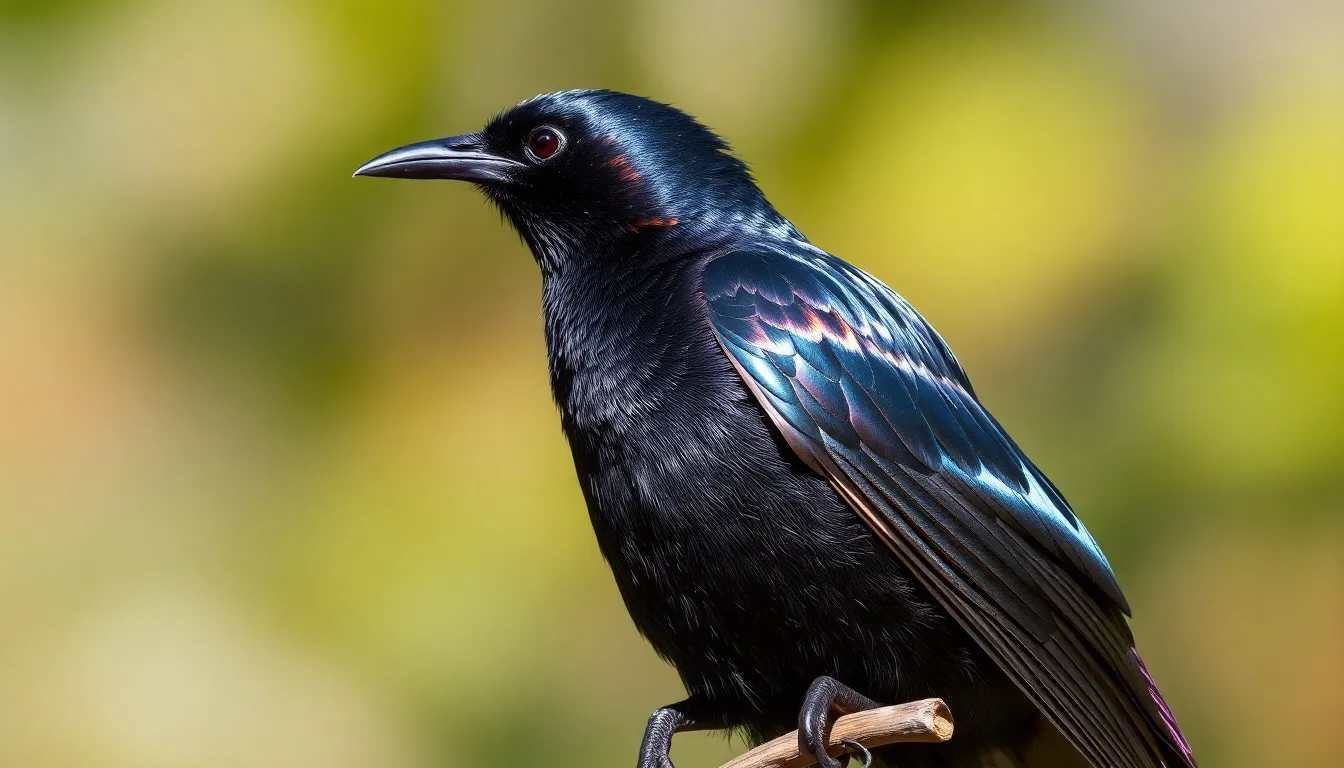
North America hosts three primary grackle species, each with distinct characteristics and regional distributions. We’ll explore these remarkable birds that have adapted to various environments across the continent.
Common Grackle
Common grackles (Quiscalus quiscula) represent the most widespread species, inhabiting regions from southern Canada to the Gulf of Mexico. Males measure 12 to 13 inches in length and weigh between 110 to 140 grams, while females are notably smaller at 9 to 11 inches and 75 to 110 grams.
Their plumage displays stunning iridescent qualities, with males showing bronze, purple and green sheens across their black feathers during breeding season. Females exhibit more subdued brown coloring with subtle bronze highlights. The species maintains strong territorial behavior during nesting season, typically from March through August.
Common grackles prefer semi-open habitats that combine woodland edges with agricultural areas. They nest in colonies of 10 to 30 pairs, constructing bulky cup nests 5 to 20 feet above ground in dense vegetation. Urban populations have increased by 15% over the past two decades due to abundant food sources and reduced natural predators.
Great-tailed Grackle
Great-tailed grackles (Quiscalus mexicanus) stand as the largest North American grackle species, with males reaching 15 to 18 inches in length and weighing up to 230 grams. Females measure significantly smaller at 11 to 13 inches and weigh between 115 to 145 grams.
Males display glossy black plumage with purple and blue iridescent highlights, complemented by their distinctive V-shaped tails that extend beyond their wing tips. Their range spans from central California through Texas and extends into Central America, with populations expanding northward at a rate of approximately 20 miles per year.
These adaptable birds thrive in urban environments, agricultural landscapes and coastal marshes. They form large communal roosts containing up to 100,000 individuals during winter months. Great-tailed grackles exhibit complex social hierarchies, with dominant males controlling prime feeding territories and attracting multiple females during breeding season.
Boat-tailed Grackle
Boat-tailed grackles (Quiscalus major) inhabit coastal regions along the Atlantic and Gulf coasts from New Jersey to Texas. Males measure 14 to 16 inches in length and weigh between 165 to 250 grams, while females are considerably smaller at 11 to 13 inches and 90 to 115 grams.
Their distinctive boat-shaped tails give this species its common name, with males displaying glossy black plumage and bright yellow eyes. Females show brown coloring with darker wing and tail feathers. Boat-tailed grackles maintain strong associations with saltwater environments, rarely venturing more than 50 miles inland.
These coastal specialists nest in marsh grasses and mangrove trees, building their nests 3 to 10 feet above water or ground level. They form smaller colonies than other grackle species, typically containing 5 to 15 breeding pairs. Their diet consists primarily of crustaceans, marine worms and small fish, with seasonal supplements of insects and agricultural grains.
Relationship with Humans
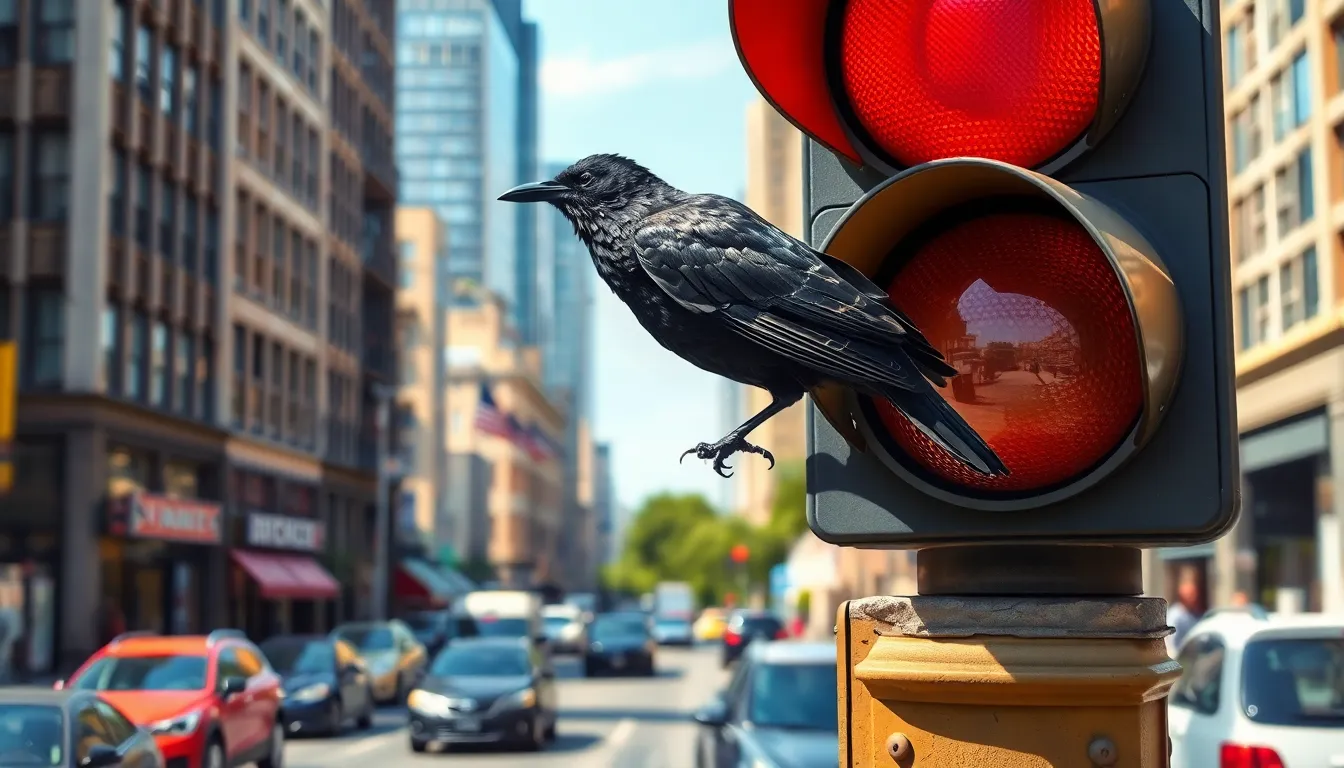
Grackles maintain complex relationships with human communities that range from admiration to frustration. These adaptable birds have successfully integrated into urban environments while simultaneously creating challenges for agricultural operations.
Urban Adaptation and City Life
Grackles demonstrate remarkable adaptability in urban environments, transforming parking lots, shopping centers, and residential neighborhoods into thriving habitats. These birds capitalize on human-provided food sources, including fast food scraps, pet food, and garbage, which supplement their natural diet by up to 40% in urban areas.
Urban grackles exhibit modified behaviors that enhance their survival in city settings. They time their feeding activities around human schedules, gathering in restaurant parking lots during peak hours and frequenting outdoor dining areas. Large communal roosts form under highway overpasses and in shopping mall parking structures, where artificial lighting provides warmth and protection from predators.
City-dwelling grackles face unique challenges including vehicle collisions, window strikes, and reduced nesting sites. But, they’ve adapted by building nests in traffic lights, building awnings, and decorative planters. Urban populations show increased aggression and territorial behavior compared to rural counterparts, likely due to resource competition and higher population densities.
Agricultural Impact and Pest Status
Grackles significantly impact agricultural operations across North America, consuming millions of dollars worth of crops annually. These birds target corn, rice, sunflower seeds, and sorghum, with individual grackles consuming up to 15% of their body weight daily during harvest seasons.
Agricultural damage patterns vary by region and crop type. In corn-producing areas, grackles cause the most destruction during the milk stage of kernel development, when one grackle can destroy 10-15 corn plants per day. Rice farmers in southern states report crop losses of 5-25% in heavily infested fields, particularly during the soft dough stage of grain development.
Farmers employ various control methods to reduce grackle damage, including frightening devices, chemical repellents, and habitat modification. Propane cannons and reflective tape systems provide temporary deterrence, while removing nearby roosting sites creates longer-term population pressure. Some agricultural operations use targeted removal programs during peak damage periods, though these require permits and professional wildlife management services.
Even though their pest status, grackles provide agricultural benefits through insect consumption. During breeding season, these birds consume large quantities of crop-damaging insects, including corn rootworm larvae, grasshoppers, and cutworms, potentially saving farmers thousands of dollars in pest control costs.
Conservation Status and Population Trends
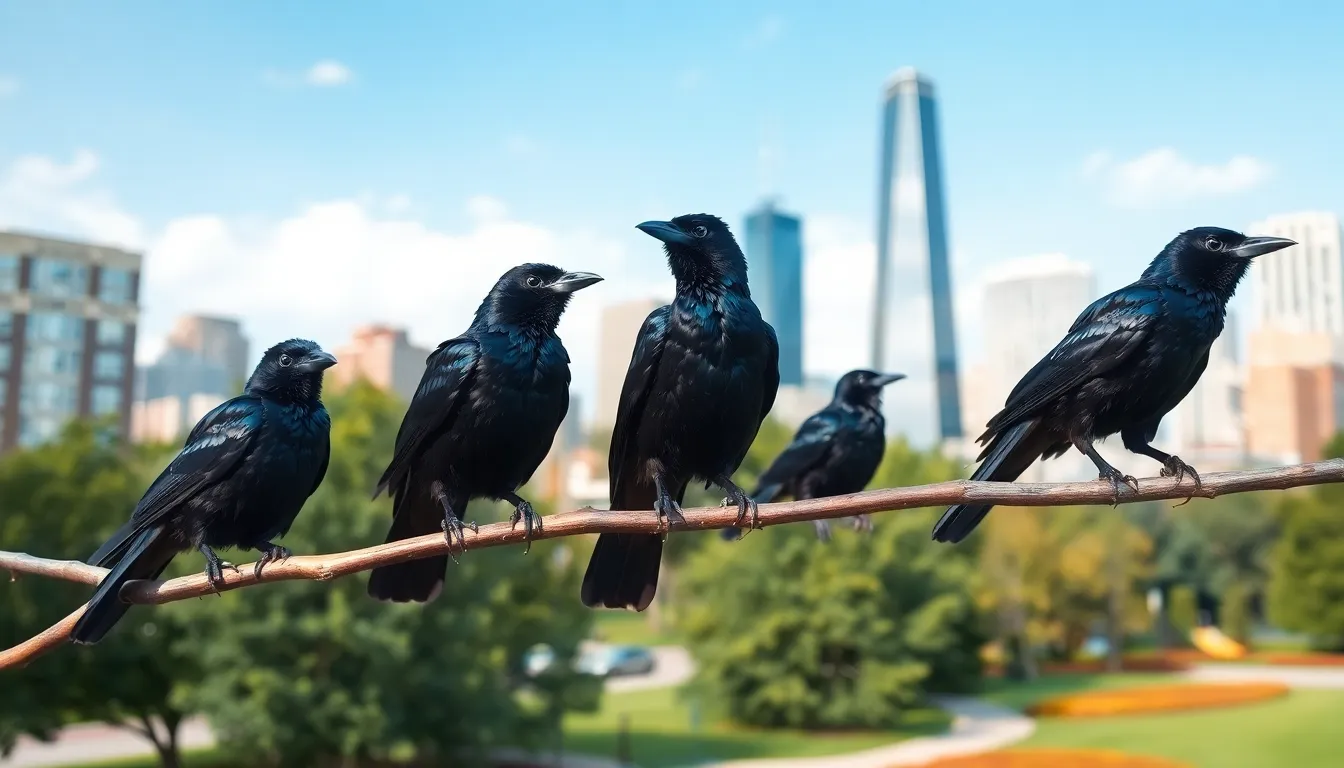
Grackle populations across North America demonstrate remarkable stability and growth patterns that defy typical wildlife decline narratives. The International Union for Conservation of Nature classifies all three primary grackle species as “Least Concern” on their Red List of Threatened Species. Common grackles maintain an estimated global population of 73 million individuals according to the North American Breeding Bird Survey data from 2019.
Great-tailed grackles show the most dramatic population expansion among the three species. Their range has extended northward by approximately 1,200 miles over the past century, with breeding populations now established in states where they were historically absent. The Christmas Bird Count records indicate a 243% population increase for great-tailed grackles between 1980 and 2020.
| Species | Population Estimate | Conservation Status | Trend (1966-2019) |
|---|---|---|---|
| Common Grackle | 73 million | Least Concern | Stable (-0.4% annually) |
| Great-tailed Grackle | 15 million | Least Concern | Increasing (+2.1% annually) |
| Boat-tailed Grackle | 2.8 million | Least Concern | Stable (+0.2% annually) |
Common grackle populations experienced regional variations in their trends over the monitoring period. Eastern populations declined by 2.9% annually between 1966 and 2019, while western populations increased by 1.8% during the same timeframe. Climate change appears to benefit grackle expansion by creating milder winters and extended growing seasons that support year-round food availability.
Urban development continues to provide new opportunities for grackle colonization. Metropolitan areas with populations exceeding 500,000 residents support grackle densities that are 340% higher than rural environments. Suburban landscapes offer optimal conditions combining open foraging areas with abundant nesting sites in ornamental trees and shrubs.
Agricultural intensification presents both challenges and benefits for grackle populations. Modern farming practices reduce natural foraging habitats but create concentrated food sources during harvest seasons. Corn production areas support some of the highest grackle breeding densities recorded, with up to 12 pairs per square kilometer in prime agricultural zones.
Boat-tailed grackles face unique conservation considerations due to their coastal habitat requirements. Sea level rise threatens approximately 23% of their current breeding range along the Atlantic and Gulf coasts. But, their populations remain stable as they adapt to modified coastal environments including marinas, waterfront developments, and constructed wetlands.
Pesticide use in agricultural areas poses minimal direct threats to grackle populations compared to other bird species. Their opportunistic feeding behavior and diverse diet reduce their vulnerability to chemical contamination. Studies from the US Geological Survey show grackle tissue samples contain pesticide residues at levels 60% lower than those found in specialized insectivorous birds.
Climate projections suggest grackle ranges will continue expanding northward through 2050. The Audubon Society’s climate change models predict common grackles could colonize suitable habitats 200 miles further north than their current breeding range. These range expansions align with human development patterns that create favorable grackle habitats.
Conclusion
Grackles represent one of nature’s most successful adaptation stories. We’ve witnessed how these remarkable birds have transformed from woodland dwellers to urban specialists thriving alongside human civilization.
Their impressive intelligence combined with flexible social behaviors allows them to exploit opportunities that challenge other species. Whether it’s solving complex foraging problems or handling bustling city environments grackles demonstrate remarkable resilience.
With stable populations and expanding ranges these birds will likely continue flourishing across North America. Understanding grackles helps us appreciate how wildlife adapts to our changing industry while reminding us that coexistence benefits both species.
Next time you encounter these iridescent birds consider their sophisticated behaviors and evolutionary success. Grackles aren’t just common backyard visitors—they’re intelligent survivors that have mastered the art of living alongside humans.
Frequently Asked Questions
What are grackles and where can I find them?
Grackles are intelligent, adaptable birds found throughout North America. Common grackles inhabit regions from southern Canada to the Gulf Coast, while great-tailed grackles are found from central California through Texas. Boat-tailed grackles live along Atlantic and Gulf coasts. They thrive in semi-open habitats, urban areas, agricultural landscapes, and wetland edges.
How big are grackles and what do they look like?
Common grackles measure 11-13 inches long, while great-tailed grackles reach 15-18 inches. Males are significantly larger than females. Male grackles have striking iridescent feathers that display vibrant colors shifting with light, strong pointed bills, and long tails. Females exhibit more subdued brown plumage. All grackles have sleek bodies built for their omnivorous lifestyle.
What do grackles eat?
Grackles are omnivorous with seasonal dietary adaptations. They consume insects during warmer months and agricultural grains, which comprise 60% of their annual intake. They also eat fast food scraps, garbage, fruits, and small animals. Their strong, pointed bills are perfectly suited for their varied diet and opportunistic feeding strategies.
Are grackles social birds?
Yes, grackles are highly social with complex behaviors. They form winter roosts containing up to 2 million individuals for safety and information sharing. They communicate through at least 12 distinct vocalizations and use body language to establish hierarchies. During breeding season, they practice colonial nesting with multiple pairs nesting close together.
How do grackles reproduce and raise their young?
Grackles breed from March to July with males establishing territories through elaborate courtship displays. They practice polygynous mating systems, with males mating with multiple females. Nests are built in dense vegetation, and both parents care for young until they fledge. Family groups stay together briefly before joining larger winter flocks.
Are grackles considered pests or beneficial birds?
Grackles have a dual relationship with humans. They can cause significant agricultural damage, particularly to corn and rice crops, leading farmers to employ various control methods. However, they also provide benefits by consuming crop-damaging insects during breeding season. In urban areas, they help control pest insects while adapting to human-provided food sources.
What’s the conservation status of grackles?
All three primary grackle species are classified as “Least Concern” by conservation organizations. Common grackles maintain a stable global population of 73 million. Great-tailed grackles show remarkable growth with a 243% population increase between 1980-2020. Climate change and urban development continue to create favorable conditions supporting their expansion.
How intelligent are grackles?
Grackles demonstrate remarkable intelligence through problem-solving skills, sound mimicry abilities, and complex social interactions. They adapt their foraging techniques based on environmental conditions, coordinate group activities through sophisticated communication, and modify behaviors to align with human activities. Their cognitive abilities contribute significantly to their urban success.

